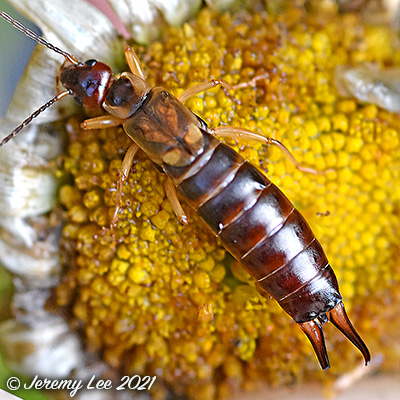
 |
|
Scientific Classifications explained » Amphibians » Ants » Aphids » Bees » Beetles » Birds » Bugs » Butterflies » Caterpillars » Damselflies » Dragonflies » Earwigs » Flies » Frog/Leafhoppers » Fungi » Galls » Grasshoppers » Harvestmen » Hoverflies » Lacewings » Ladybirds » Leaf Mines » Lichens » Mammals » Millipedes » Mosses » Moths » Sawflies » Slugs » Snails » Spiders » Trees & Shrubs » Wasps » Wild Flowers » Woodlice » Postboxes |
UK Nature > Earwigs > Forficula auricularia

Scientific Name: Forficula auricularia Common Name: Common Earwig Forficula auricularia, or the Common Earwig, has a length of 10-15mm, excluding the pincers. The latter are 4-9mm in the male, strongly curved and with a flat base. Female pincers are 4-5mm and almost straight. The body is shiny brown, with the hindwings projecting as short triangles from under the short forewings. Mainly vegetarian, eating a wide range of living and dead plant material, but also taking some insect food. Largely nocturnal, hiding under loose bark and in other crevices by day. Young earwigs always have straight, slender pincers. The white or cream earwigs that are often unearthed in the garden are not different species; simply individuals that have just changed their skins. Adult all year, but usually dormant in winter. Abundant almost everywhere, in the house as well as in the garden. Often in trees, commonly nestling in clusters of apples in late summer. Throughout Europe and the only earwig commonly seen in the UK. |
|

https://www.uknature.co.uk is a website dedicated to showing the immense diversity of UK nature and wildlife. Our vast range of habitats, from lowland arable to snow covered mountains, from storm-ravaged coastlines to peaceful inland freshwater lakes and rivers, from dry, sandy heaths to deciduous and coniferous forests, all these habitats contribute to the abundance of UK nature. We have wild birds in huge numbers either residing or visiting our shores (597 recorded species as at July 2013) and we must also not forget the humble back garden with its grass lawns, flower beds filled with nectar rich flowers, shrubs and trees, all designed to attract huge numbers of insects such as bees, moths, butterflies and hoverflies; and finally the small ponds which provide safe havens for frogs, toads, newts and even slow worms and grass snakes. www.uknature.co.uk is the showcase for my personal passion, photographing uknature in all its glory. I sincerely hope you all enjoy the fruits of my labours. This site and all images contained therein is © Jeremy Lee 2004 - 2025. All Rights Reserved. Site design by Jeremy Lee. Site development & IT Support by Stuart Lee. |